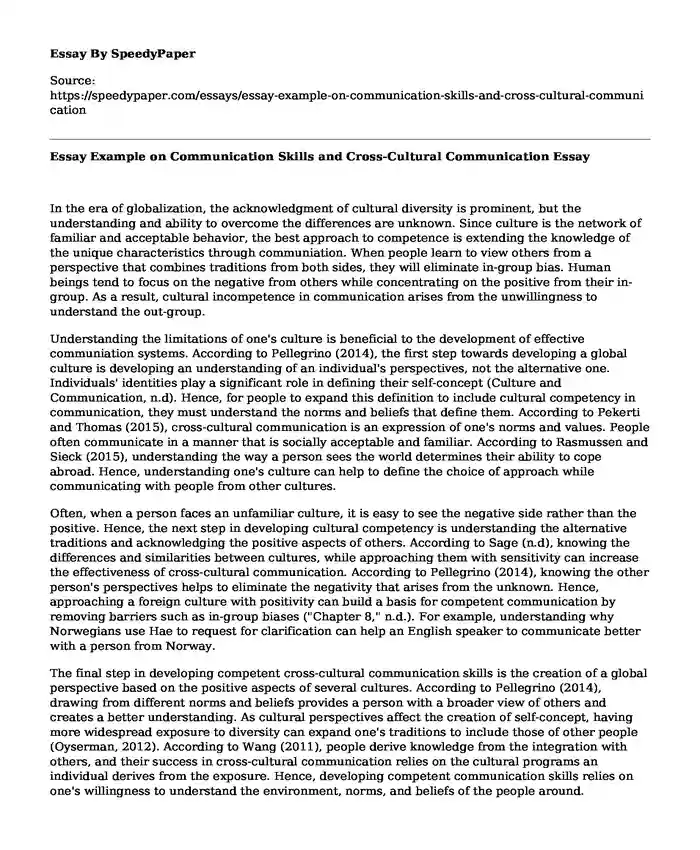
| Type of paper: | Essay |
| Categories: | Multiculturalism Intercultural communication Communication skills |
| Pages: | 3 |
| Wordcount: | 701 words |
In the era of globalization, the acknowledgment of cultural diversity is prominent, but the understanding and ability to overcome the differences are unknown. Since culture is the network of familiar and acceptable behavior, the best approach to competence is extending the knowledge of the unique characteristics through communiation. When people learn to view others from a perspective that combines traditions from both sides, they will eliminate in-group bias. Human beings tend to focus on the negative from others while concentrating on the positive from their in-group. As a result, cultural incompetence in communication arises from the unwillingness to understand the out-group.
Understanding the limitations of one's culture is beneficial to the development of effective communiation systems. According to Pellegrino (2014), the first step towards developing a global culture is developing an understanding of an individual's perspectives, not the alternative one. Individuals' identities play a significant role in defining their self-concept (Culture and Communication, n.d). Hence, for people to expand this definition to include cultural competency in communication, they must understand the norms and beliefs that define them. According to Pekerti and Thomas (2015), cross-cultural communication is an expression of one's norms and values. People often communicate in a manner that is socially acceptable and familiar. According to Rasmussen and Sieck (2015), understanding the way a person sees the world determines their ability to cope abroad. Hence, understanding one's culture can help to define the choice of approach while communicating with people from other cultures.
Often, when a person faces an unfamiliar culture, it is easy to see the negative side rather than the positive. Hence, the next step in developing cultural competency is understanding the alternative traditions and acknowledging the positive aspects of others. According to Sage (n.d), knowing the differences and similarities between cultures, while approaching them with sensitivity can increase the effectiveness of cross-cultural communication. According to Pellegrino (2014), knowing the other person's perspectives helps to eliminate the negativity that arises from the unknown. Hence, approaching a foreign culture with positivity can build a basis for competent communication by removing barriers such as in-group biases ("Chapter 8," n.d.). For example, understanding why Norwegians use Hae to request for clarification can help an English speaker to communicate better with a person from Norway.
The final step in developing competent cross-cultural communication skills is the creation of a global perspective based on the positive aspects of several cultures. According to Pellegrino (2014), drawing from different norms and beliefs provides a person with a broader view of others and creates a better understanding. As cultural perspectives affect the creation of self-concept, having more widespread exposure to diversity can expand one's traditions to include those of other people (Oyserman, 2012). According to Wang (2011), people derive knowledge from the integration with others, and their success in cross-cultural communication relies on the cultural programs an individual derives from the exposure. Hence, developing competent communication skills relies on one's willingness to understand the environment, norms, and beliefs of the people around.
Conclusion
In summary, communities have unique characteristics that define acceptable traditions. People from such social organizations derive their self-concept from the familiar norms and belief they encounter. The impact of in-group bias determines their willingness to understand another from a different culture and limits their interaction. Hence, to overcome the difficulties of cross-cultural communication, individuals must understand their norms and beliefs, view alternative ones with positivity, and create a global perspective that incorporates several views.
References
Chapter 8: Culture and communication. (n.d.). Retrieved from http://open.lib.umn.edu/communication/part/chapter-8-culture-and-communication/
Oyserman, Daphna. (2012). Self-Concept and Identity.
Pekerti, A & Thomas, David. (2015). The role of self-concept in cross-cultural communication. International Journal of Cross-Cultural Management. 15. doi:10.1177/1470595814564767.
Pellegrino, R. (2014). Cross-cultural communication [Video file]. Retrieved from https://www.youtube.com/watch?v=YMyofREc5Jk&vl=en
Rasmussen, L. J., &Sieck, W. R. (2015).Culture-general competence: Evidence from a cognitive field study of professionals who work in many cultures.International Journal of Intercultural Relations, 14(3), 75-90. doi:10.1016/j.ijintrel.2015.03.014
Sage. (n.d.).Culture and communication in the global workplace [PDf file]. Retrieved from https://us.sagepub.com/sites/default/files/upm-binaries/76726_Chapter_8.pdf
Wang, J. (2011). Communication and cultural competence: The acquisition of cultural knowledge and behavior. Online Readings in Psychology and Culture, 7(1), 3.
Cite this page
Essay Example on Communication Skills and Cross-Cultural Communication. (2023, Jan 13). Retrieved from https://speedypaper.com/essays/essay-example-on-communication-skills-and-cross-cultural-communication
Request Removal
If you are the original author of this essay and no longer wish to have it published on the SpeedyPaper website, please click below to request its removal:
- Free Essay Sample on Interdisciplinary Collaboration in Shared Governance
- Essay Sample on the Use of Vaccinations
- Free Essay about the Story, Tim Gun And The Leakey Shower; Welcome To My Life Little Guy
- Definition of Criminal Justice
- Essay Sample on Ethical Issues in the Workplace
- Essay Sample on Theology and Civil Rights
- Paper Example: The Federal Emergency Management Agency
Popular categories




